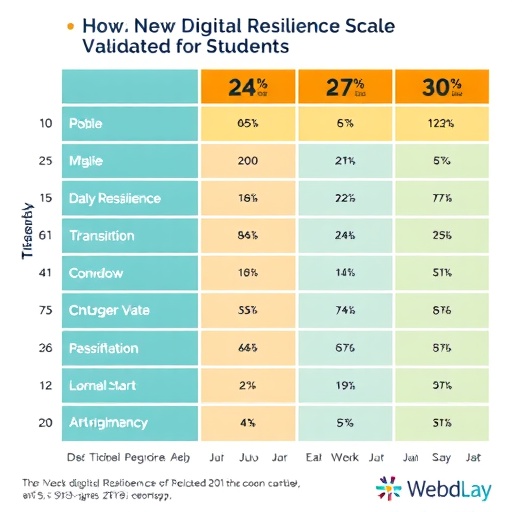In an era increasingly dominated by digital connectivity, understanding how young individuals navigate online challenges has become more critical than ever. A pioneering study by Pan, Q., Lan, M., Tan, C.Y., and colleagues, slated for publication in BMC Psychology in 2025, marks a significant leap forward in this realm by introducing a comprehensive digital resilience scale tailored specifically for primary and secondary school students. This tool not only quantifies youths’ capacity to withstand digital adversities but also provides a nuanced framework for enhancing psychological fortitude in the digital age.
Digital resilience, as conceptualized in this groundbreaking research, transcends mere coping mechanisms. It encompasses a multifaceted suite of skills, behaviors, and attitudes that allow young users to effectively manage and recover from negative online experiences, including cyberbullying, misinformation, and privacy breaches. The study pioneers a measurement instrument that captures these dimensions with unprecedented precision, reflecting the unique psychological and developmental contexts of children and adolescents.
The methodology employed by the research team stands out for its rigorous design and validation processes. The scale was developed through extensive qualitative and quantitative phases, starting with in-depth interviews and focus groups involving students, educators, and digital psychology experts. This groundwork ensured that the scale’s items resonate authentically with the lived experiences of the target population. Following this, large-scale surveys were conducted across diverse demographic samples to test the scale’s reliability and validity, employing advanced statistical techniques like confirmatory factor analysis and item response theory to refine its psychometric robustness.
One of the most compelling aspects of this digital resilience scale is its differentiation among various resilience domains. It assesses cognitive resilience, such as critical thinking and digital literacy; emotional resilience, including emotional regulation and stress management; and social resilience, which covers peer support and community engagement online. This tripartite structure acknowledges that resilience is not monolithic but operates through interconnected layers that collaboratively foster adaptive digital behaviors.
The implications of this tool are profound for educators, policymakers, and mental health professionals. By providing a diagnostic lens into students’ digital resilience, the scale enables targeted interventions that bolster weak areas while reinforcing strengths. For instance, educational curricula can be tailored to integrate resilience-building modules that focus on improving critical digital competencies and socio-emotional skills. Moreover, mental health practitioners can leverage the scale to identify students vulnerable to digital stressors and design appropriate counseling strategies.
Significantly, the research addresses cultural and contextual variations in digital experiences. Recognizing that digital challenges and resources differ across regions and communities, the scale was validated among diverse cohorts to ensure its applicability in multiple sociocultural settings. This global perspective enriches the scale’s relevance, allowing it to serve as a foundation for cross-cultural studies and worldwide resilience-promoting initiatives.
The authors also underscore the dynamic nature of digital resilience, emphasizing the scale’s utility in longitudinal assessments. As digital environments evolve rapidly, ongoing measurement of resilience levels can track the efficacy of educational programs and policy changes over time. This temporal sensitivity is essential for responding adaptively to emerging online threats and opportunities that affect youth wellbeing.
Technologically, the researchers incorporated modern digital data collection methods such as mobile app-based surveys and interactive online assessments, enhancing engagement and accuracy among young respondents. These innovations bridge research and real-world application, facilitating widespread adoption in school settings and remote learning environments.
Importantly, the study situates digital resilience within the broader framework of psychological resilience, linking online experiences with offline mental health outcomes. The scale’s predictive validity was examined by correlating resilience scores with indices of anxiety, depression, and social isolation, revealing critical insights into how digital engagement impacts overall psychological functioning in youths.
The creation and validation of this scale arrive at a pivotal moment as society grapples with the mental health repercussions of expanding digital interaction among children and adolescents. By equipping stakeholders with a scientifically grounded, practical tool, Pan and colleagues provide a vital resource in the collective effort to nurture healthier digital citizens who can thrive amid the challenges of contemporary technological landscapes.
Beyond its immediate academic and practical contributions, the study generates considerable public interest due to the universal relevance of digital experiences among youth. It opens new avenues for interdisciplinary collaborations integrating psychology, education, technology, and public health to foster innovative resilience-building programs.
Future research directions proposed by the authors include adapting the scale for younger children and extending it to assess resilience in special populations, such as neurodiverse students or those with existing mental health conditions. This adaptability speaks to the scale’s foundational structure and its potential to evolve alongside emerging scientific insights and social trends.
In essence, the development of the digital resilience scale represents not only a methodological achievement but also a societal imperative. By systematically understanding and enhancing young individuals’ capacity to navigate digital adversities, this research contributes fundamentally to shaping a safer, more supportive digital ecosystem for the next generations.
As digital platforms continue to intertwine with daily life worldwide, the insights from this study are poised to influence educational policies, mental health frameworks, and youth empowerment strategies at local, national, and international levels, heralding a new frontier in psychological resilience research tailored for the digital age.
Subject of Research: Development and validation of a digital resilience scale for primary and secondary school students
Article Title: Development and validation of digital resilience scale for primary and secondary school students
Article References:
Pan, Q., Lan, M., Tan, C.Y. et al. Development and validation of digital resilience scale for primary and secondary school students. BMC Psychol (2025). https://doi.org/10.1186/s40359-025-03739-0
Image Credits: AI Generated




